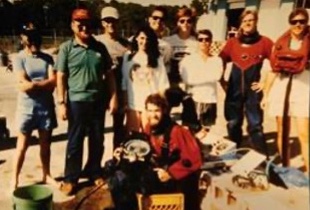A foreword by Chris Peters, Diving Safety Officer (DSO) of the FSU Coastal and Marine Lab
 I met Gregg in 2016, just a few days after moving to Tallahassee from Hawai'i to take the position as FSU’s new Diving Safety Officer. He arrived at the Marine Lab overflowing with experience and confidence – two things he soon learned I was lacking. Fortunately, being the generous person he was, he was eager to share. I still remember the advice he gave with a bright smile, on how to approach my new position - “You are the scientific diving coordinator. You should be a facilitator.” Over the next few years, he guest lectured for the scientific diving course, proudly sharing with students the wonderful stories of his expeditions to K-Tower, Palau, and Antarctica.
I met Gregg in 2016, just a few days after moving to Tallahassee from Hawai'i to take the position as FSU’s new Diving Safety Officer. He arrived at the Marine Lab overflowing with experience and confidence – two things he soon learned I was lacking. Fortunately, being the generous person he was, he was eager to share. I still remember the advice he gave with a bright smile, on how to approach my new position - “You are the scientific diving coordinator. You should be a facilitator.” Over the next few years, he guest lectured for the scientific diving course, proudly sharing with students the wonderful stories of his expeditions to K-Tower, Palau, and Antarctica.
Gregg’s contributions to diving science extend far beyond FSU, but it’s here that I feel his impact - 25 years of ambition and a willingness to go where others had not gone before. I can only imagine how many wonderful stories he had and shared with the thousands of other divers he impacted along his way. As it turned out, Gregg and I would trade places in more ways than one, as he would soon move to the Hamakua Coast on the Big Island of Hawai'i, just a short drive from where I’d lived. Aloha Gregg, and Mahalo.
 Florida State University’s first and longest-tenured Diving Safety Officer, Gregg R. Stanton, passed away earlier this month at the age of 76. Gregg trained in the Scientist in the Sea Program (SITS) under the tutelage of the U.S. Navy Captain George F. Bond, M.D., the father of saturation diving, before bringing his experience and ambition to FSU. Upon arriving at FSU, he developed the Academic Diving Program.
Florida State University’s first and longest-tenured Diving Safety Officer, Gregg R. Stanton, passed away earlier this month at the age of 76. Gregg trained in the Scientist in the Sea Program (SITS) under the tutelage of the U.S. Navy Captain George F. Bond, M.D., the father of saturation diving, before bringing his experience and ambition to FSU. Upon arriving at FSU, he developed the Academic Diving Program.
Gregg was well-known in the scientific diving community for his development of new technologies. He performed numerous advanced subsea projects including manned undersea habitats and Antarctic expeditions. He incorporated and trained a team in deep cave diving to capture rare primitive crustaceans. When Gregg started work, the FSUCML did not have a coastal research vessel. To remedy this, he was instrumental in acquiring the R/V Seminole, a 47 ft. diesel-powered vessel that served FSU for decades of scientific diving. Through the 1980s and 1990s, Gregg supervised training, equipment collection, and safety protocols which enabled thousands of FSU faculty, staff, and students to explore the underwater world. In 2000, he created the FSU Panama City Advanced Scientific Diving Program and served as the first Director of the Underwater Crime Scene Investigation Program.
 In total, he participated in over 300 student-driven aquatic projects, and over 100 faculty projects, diving from the caves of Wakulla, and under the ice of Antarctica, to H2SO4 lakes in Palau, and the cenotes in Mexico. In 2014, he was awarded the prestigious Conrad Limbaugh Prize by the American Academy of Underwater Sciences for his contributions to diving science.
In total, he participated in over 300 student-driven aquatic projects, and over 100 faculty projects, diving from the caves of Wakulla, and under the ice of Antarctica, to H2SO4 lakes in Palau, and the cenotes in Mexico. In 2014, he was awarded the prestigious Conrad Limbaugh Prize by the American Academy of Underwater Sciences for his contributions to diving science.
Article by Chris Peters with help from Dr. William “Doc” Herrnkind

